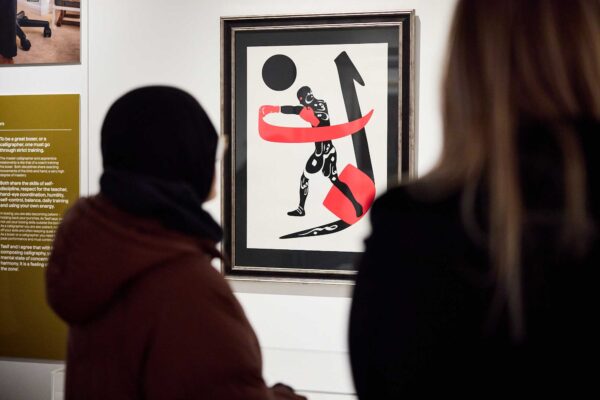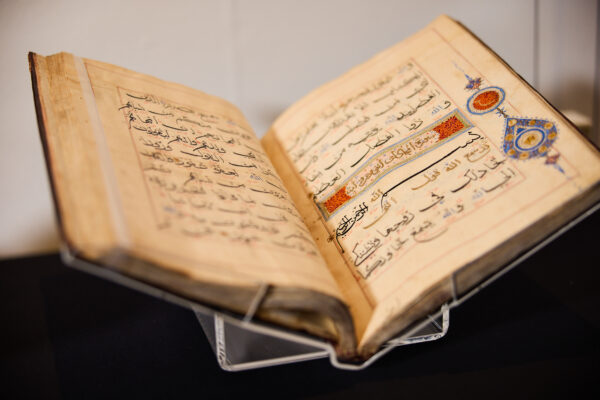
Razwan Ul-Haq on calligraphy, boxing and movement with meaning
Exploring why movement matters in both art and life.
Published: November 6, 2025
Meet Bradford artist and calligrapher Razwan Ul-Haq.
Artist Razwan Ul-Haq created a striking calligraphy artwork ‘Writing to be Heard’ for the Fighting To Be Heard exhibition, part of the Bradford 2025 programme. The exhibition explored connections between boxing and calligraphy through the eyes of a group of British South Asian Muslim men living in Bradford today.
Razwan’s artwork is also featured in the Bradford Made ‘Fighting To Be Heard’ activity pack – part of the Local Stories for Learners collection. We spoke to him about why movement matters in both art and life.
Can you tell us a bit about yourself and your creative practice?
I began Arabic calligraphy using hand-cut bamboo pens, as a young person growing up in Lancashire, inspired by my uncle, Maulvi Fazal Azeem – an award-winning Arabic calligrapher and scribe. That early foundation gave me a deep respect for the tradition. I’ve also been boxing at the Tasif Khan Community Boxing Academy for over six years and have been inspired by the parallels between the sport and Calligraphy.
Can you talk us through the piece you created which is featured in the activity pack – what inspired it? What do you want learners to take away from it?
The exhibition was full of written materials – books, manuscripts, letters – so I wanted to create something that could stand out while still being rooted in language.
I’d made some calligraphy pieces at the boxing academy and at home, but they were too papery, too book-ey and I felt there was a danger they would just fall away in the background. This needed to be bolder. It also had to reflect the project’s broader journey – from early Qur’anic manuscripts to modern cultural expression. Somewhere there needed to be some technology, but the traditional needed to be there too.
The large red nuqta (dot) and ba in the final artwork are both significant. In Calligraphy, the nuqta is a starting point – it represents grounding – much like footwork in boxing, which was something trainers at the boxing academy really emphasised. The red large ‘ba’ stroke, is what comes to mind many times when I watch boxers as they are training. The calligraphy spells out “Actions Speak Louder than Words” – a message that’s clear and deliberate.
Both Boxing and Calligraphy are about perfecting one’s movement. On the artwork, notice the push stroke of the Qalam (pen), and the one push punch of the boxer – the movement of the body corresponds with the stroke. Although boxing is a contact sport, note the subtle ballet type movement in the figure. Tasif, founder of Tasif Khan Community Boxing Academy, emphasises again and again never to use boxing skills outside the ring. I also feel that Calligraphy should always only be used for positive purposes.
I hope the piece sparks a sense of excitement – that it helps learners and educators see boxing and calligraphy in a new light. Both are disciplines rooted in movement, control and expression. I wanted this piece to open up those parallels.

Did working on this project connect with your own experiences or memories of Bradford?
Definitely! It took me right back to training at the boxing gym, and running through the Bradford district after those sessions.
It’s so important for young people to explore local stories and histories connected to the places around them – it gives them a sense of belonging and perspective. We all need some kind of temporary anchor – something that grounds us while we explore the wider world.
Where can we stay up to date with your next projects?
Lately, I’ve been working on an ink-making project, which you can find on YouTube: Ink Making Playlist. Follow my work on my website at: www.ulhaq.com
